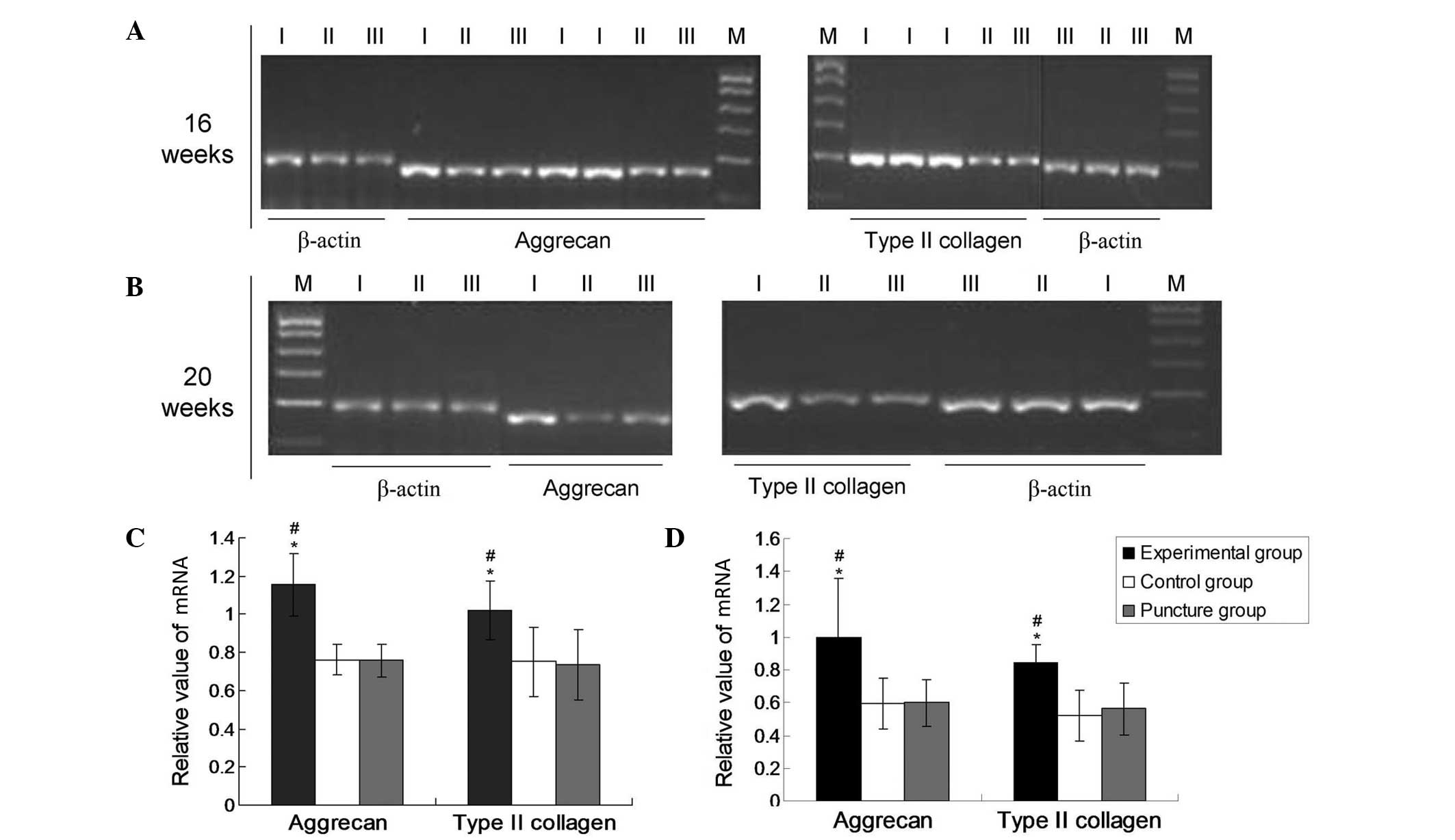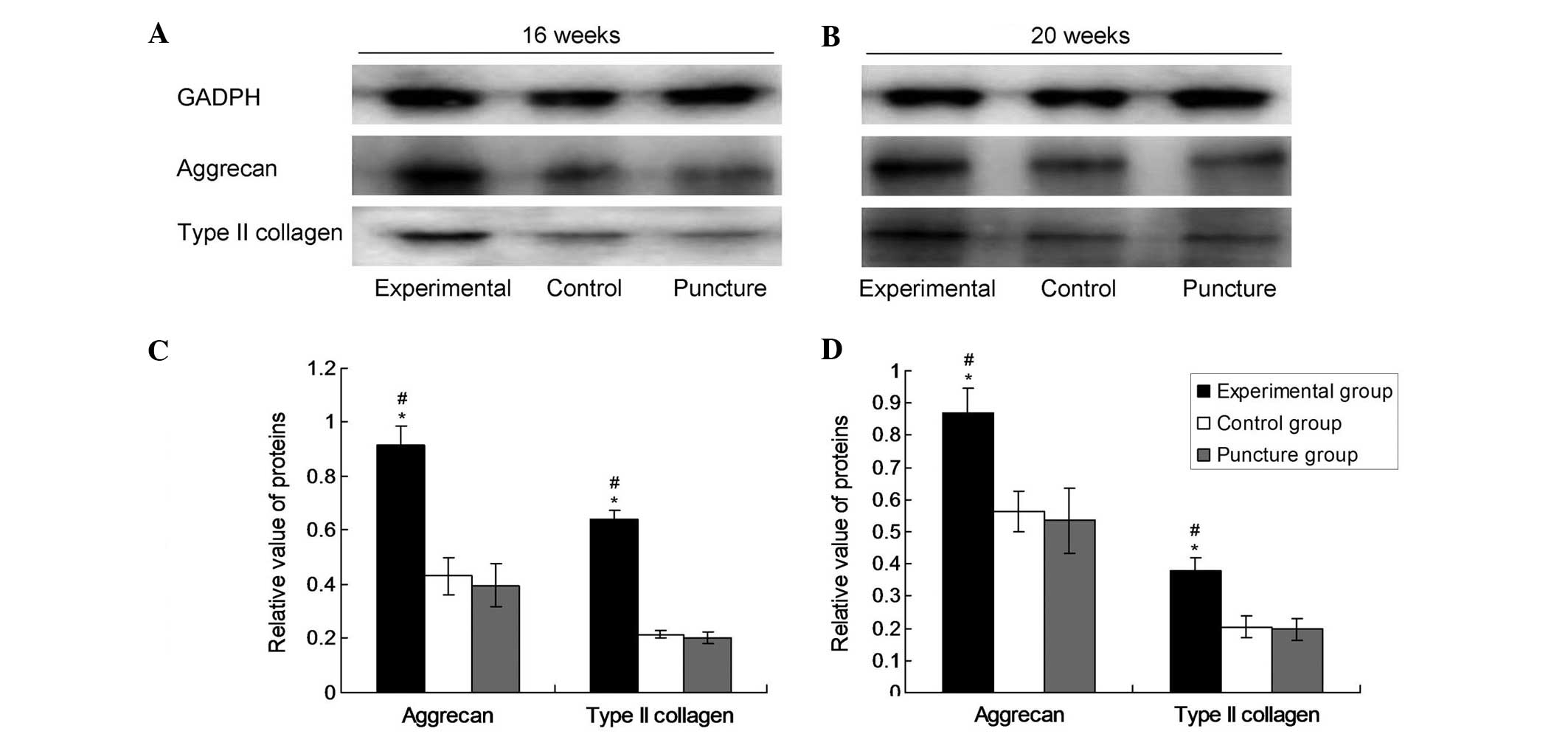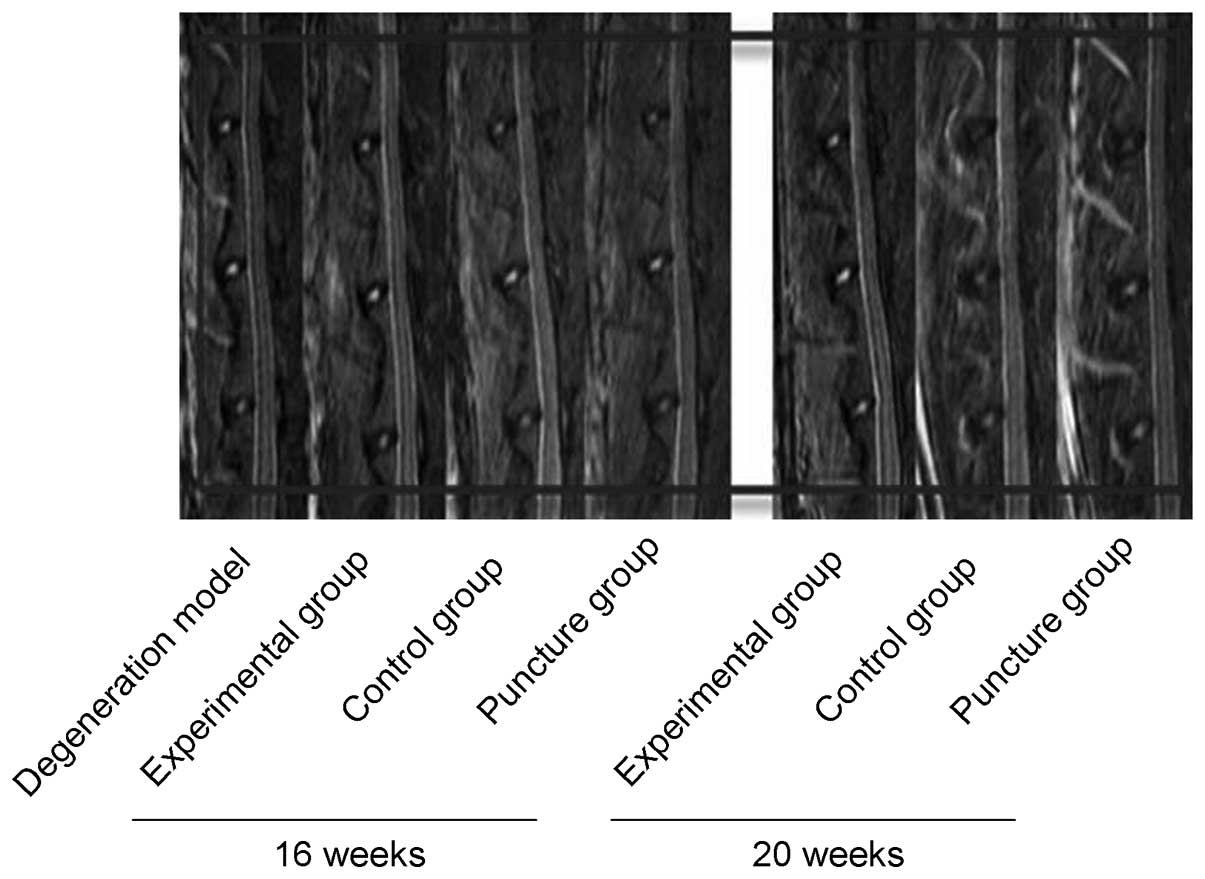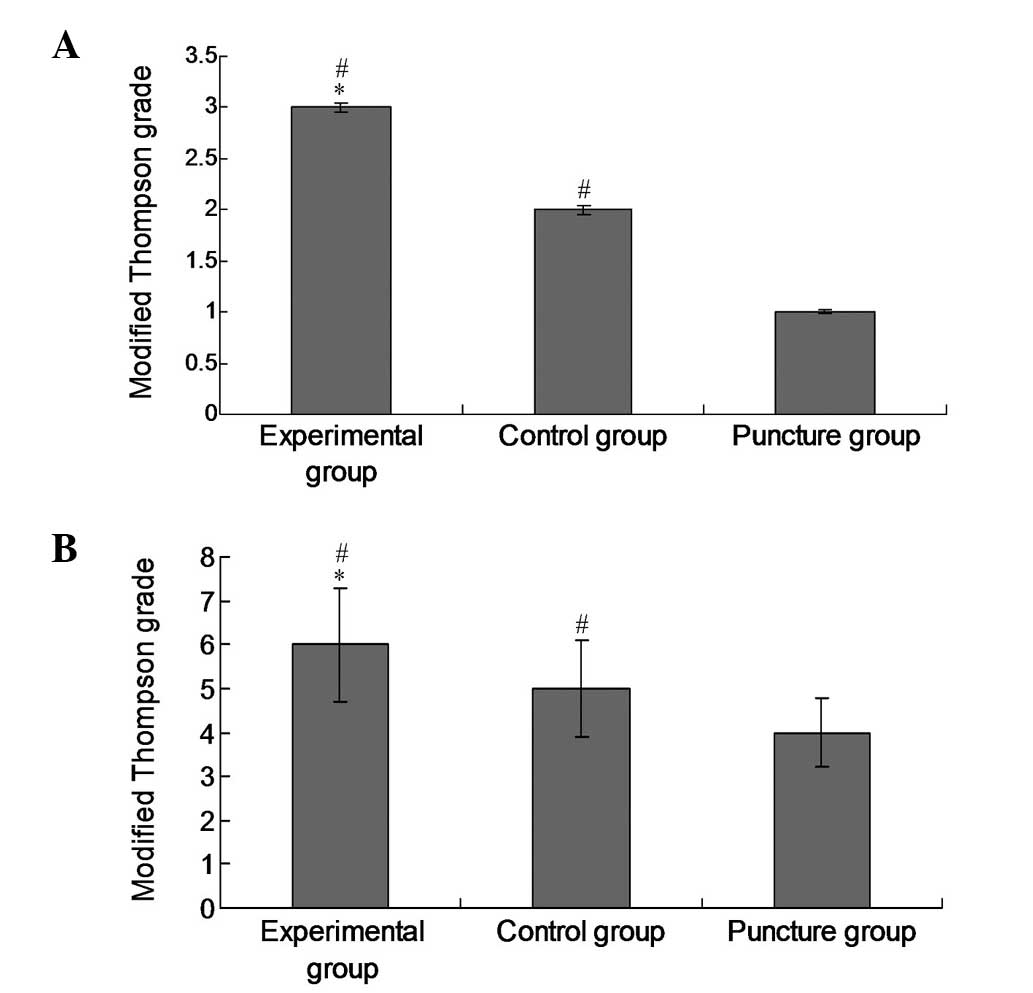|
1
|
Takatalo J, Karppinen J, Niinimäki J,
Tainela S, Näyhä S, Mutanen P, Sequeiros RB, Kylönen E and Tervonen
O: Does lumbar disc degeneration on magnetic resonance imaging
associate with low back symptom severity in young Finnish adults?
Spine. 36:2180–2189. 2011. View Article : Google Scholar : PubMed/NCBI
|
|
2
|
Park P, Garton HJ, Gala VC, Hoff JT and
McGillicuddy JE: Adjacent segment disease after lumbar or
lumbosacral fusion: Review of the literature. Spine (Phila Pa
1976). 29:1938–1944. 2004. View Article : Google Scholar : PubMed/NCBI
|
|
3
|
Cui K, Zhou X, Luo J, Feng J, Zheng M,
Huang D, Jiang J, Chen X, Wei Y, Li J and Yang L: Dual gene
transfer of bFGF and PDGF in a single plasmid for the treatment of
myocardial infarction. Exp Ther Med. 7:691–696. 2014.PubMed/NCBI
|
|
4
|
Liu Y, Kong J, Chen BH and Hu YG: Combined
expression of CTGF and tissue inhibitor of metalloprotease-1
promotes synthesis of proteoglycan and collagen type II in rhesus
monkey lumbar intervertebral disc cells in vitro. Chin Med J
(Engl). 123:2082–2087. 2010.PubMed/NCBI
|
|
5
|
Jiang F, Yue B, Ma XX, Zhang GQ, Hu YG and
Chen BH: Construction and detection of lentiviral plasmids
containing human transforming growth factor beta 3, connective
tissue growth factor and tissue inhibitor of metalloproteinases 1
gene. Zhongguo Zuzhi Gongcheng Yanjiu Yu Linchuang Kangfu.
16:699–703. 2012.(In Chinese).
|
|
6
|
Sobajima S, Kompel JF, Kim JS, Wallach CJ,
Robertson DD, Vogt MT, Kang JD and Gilbertson LG: A slowly
progressive and reproducible animal model of intervertebral disc
degeneration characterized by MRI, X-ray and histology. Spine
(Phila Pa 1976). 30:15–24. 2005. View Article : Google Scholar : PubMed/NCBI
|
|
7
|
Masuda K, Aota Y, Muehleman C, Imai Y,
Okuma M, Thonar EJ, Andersson GB and An HS: A novel rabbit model of
mild, reproducible disc degeneration by an anulus needle puncture:
Correlation between the degree of disc injury and radiological and
histological appearances of disc degeneration. Spine (Phila Pa
1976). 30:5–14. 2005. View Article : Google Scholar : PubMed/NCBI
|
|
8
|
Tsirimonaki E, Fedonidis C, Pneumaticos
SG, Tragas AA, Michalopoulos I and Mangoura D: PKCε signalling
activates ERK1/2, and regulates aggrecan, ADAMTS5, and miR377 gene
expression in human nucleus pulposus cells. PLoS One. 8:e820452013.
View Article : Google Scholar : PubMed/NCBI
|
|
9
|
Yang H, Wu J, Liu J, Ebraheim M, Castillo
S, Liu X, Tang T and Ebrahein NA: Transplanted mesenchymal stem
cells with pure fibrinous gelatin-transforming growth factor-beta1
decrease rabbit intervertebral disc degeneration. Spine J.
10:802–810. 2010. View Article : Google Scholar : PubMed/NCBI
|
|
10
|
Antoniou J, Steffen T, Nelson F,
Winterbottom N, Hollander AP, Polle RA, Aebi M and Alini M: The
human lumbar intervertebral disc: Evidence for changes in the
biosynthesis and denaturation of the extracellular matrix with
growth, maturation, ageing, and degeneration. J Clin Invest.
98:996–1003. 1996. View Article : Google Scholar : PubMed/NCBI
|
|
11
|
Leung VY, Chan D and Cheung KM:
Regeneration of intervertebral disc by mesenchymal stem cells:
Potentials, limitations, and future direction. Eur Spine J.
15:406–413. 2006. View Article : Google Scholar
|
|
12
|
Pearce RH, Grimmer BJ and Adams ME:
Degeneration and the chemical composition of the human lumbar
intervertebral disc. J Orthop Res. 5:198–205. 1987. View Article : Google Scholar : PubMed/NCBI
|
|
13
|
ten Dijke P, Hansen P, Iwata KK, Pieler C
and Foulkes JG: Identification of another member of the
transforming growth factor type beta gene family. Proc Natl Acad
Sci USA. 85:4715–4719. 1988. View Article : Google Scholar : PubMed/NCBI
|
|
14
|
Risbud MV, Di Martino A, Guttapalli A,
Seghatoleslami R, Denaro V, Vaccaro AR, Albert TJ and Shapiro IM:
Toward an optimum system for intervertebral disc organ culture:
TGF-beta 3 enhances nucleus pulposus and anulus fibrosus survival
and function through modulation of TGF-beta-R expression and ERK
signaling. Spine (Phila Pa 1976). 31:884–890. 2006. View Article : Google Scholar : PubMed/NCBI
|
|
15
|
Nakanishi T, Nishida T, Shimo T, Kobayashi
K, Kubo T, Tamatani T, Tezuka K and Takigawa M: Effects of
CTGF/Hcs24, a product of a hypertrophic chondrocyte-specific gene,
on the proliferation and differentiation of chondrocytes in
culture. Endocrinology. 141:264–273. 2000. View Article : Google Scholar : PubMed/NCBI
|
|
16
|
McLennan SV, Wang XY, Moreno V, Yue DK and
Twigg SM: Connective tissue growth factor mediates high glucose
effects on matrix degradation through tissue inhibitor of matrix
metalloproteinase type 1: Implications for diabetic nephropathy.
Endocrinology. 145:5646–5655. 2004. View Article : Google Scholar : PubMed/NCBI
|
|
17
|
Bachmeier BE, Nerlich A, Mittermaier N,
Weiler C, Lumenta C, Wuertz K and Boos N: Matrix metalloproteinase
expression levels suggest distinct enzyme roles during lumbar disc
herniation and degeneration. Eur Spine J. 18:1573–1586. 2009.
View Article : Google Scholar : PubMed/NCBI
|
|
18
|
Yang H, Wu J, Liu J, Ebraheim M, Castillo
S, Liu X, Tang T and Ebraheim NA: Transplanted mesenchymal stem
cells with pure fibrinous gelatin-transforming growth factor-beta1
decrease rabbit intervertebral disc degeneration. Spine J.
10:802–810. 2010. View Article : Google Scholar : PubMed/NCBI
|
|
19
|
Zhao H, Ni CF, Huang J, Zhao SM, Gu WW,
Jiang H, Chen L and Tan TS: Effects of bone cement on
intervertebral disc degeneration. Exp Ther Med. 7:963–969.
2014.PubMed/NCBI
|
|
20
|
Masuda K: Biological repair of the
degenerated intervertebral disc by the injection of growth factors.
Eur Spine J. 17:S441–S451. 2008. View Article : Google Scholar
|
|
21
|
Miyoshi H, Smith KA, Mosier DE, Verma IM
and Toebett BE: Transduction of human CD34+ cells that
mediate long-term engraftment of NOD/SCID mice by HIV vectors.
Science. 283:682–686. 1999. View Article : Google Scholar : PubMed/NCBI
|
|
22
|
Naldini L, Blomer U, Gallay P, Ory D,
Mulligan R, Gage FH, Verma IM and Frono D: In vivo gene delivery
and stable transduction of nondividing cells by a lentiviral
vector. Science. 272:263–267. 1996. View Article : Google Scholar : PubMed/NCBI
|
|
23
|
de Santoni Sio F and Naldini L: Short-term
culture of human CD34+ cells for lentiviral gene transfer. Methods
Mol Biol. 506:59–70. 2009. View Article : Google Scholar : PubMed/NCBI
|
|
24
|
Zamule SM, Strom SC and Omiecinski CJ:
Preservation of hepatic phenotype in lentiviral-transduced primary
human hepatocytes. Chem Biol Interact. 173:179–186. 2008.
View Article : Google Scholar : PubMed/NCBI
|


















